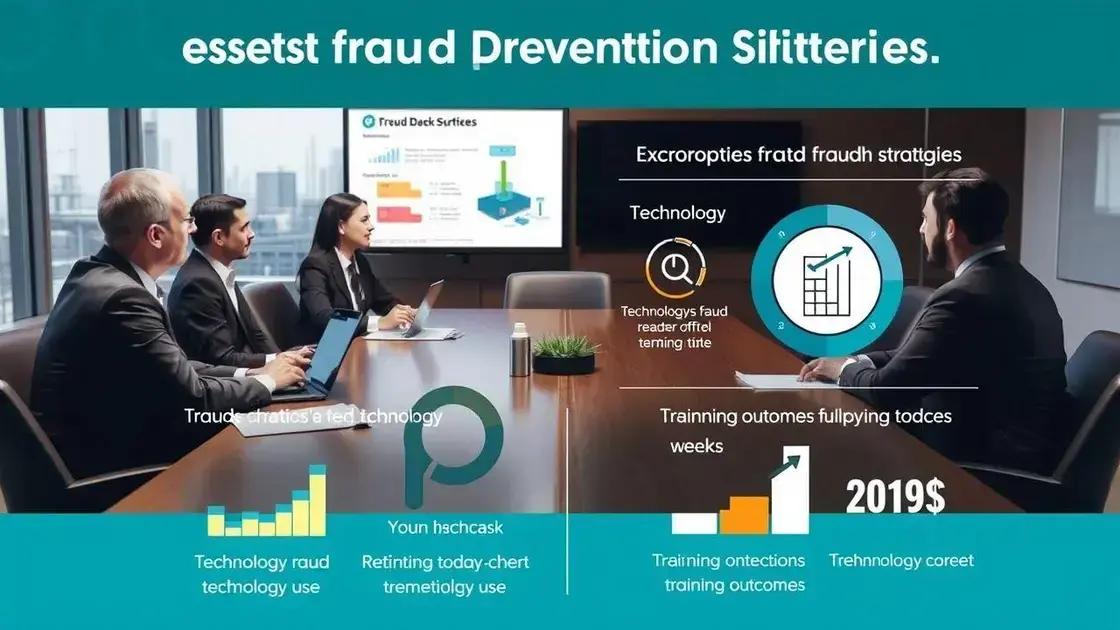Benefit fraud prevention: how it can save your business

Anúncios
Benefit fraud prevention involves implementing training, technology, and reporting systems to reduce fraudulent claims and protect organizational resources effectively.
Benefit fraud prevention is essential for safeguarding your business. By understanding the various types of fraud, you can protect your resources and enhance your operations. Have you considered how effective strategies can make a significant difference in your organization?
Anúncios
Understanding benefit fraud
Understanding benefit fraud is crucial for any organization. It not only affects finances but also damages reputations. This type of fraud can take many forms, and identifying it early can save businesses significant resources.
What is benefit fraud?
Benefit fraud occurs when individuals or organizations deceive the system to gain benefits they aren’t entitled to. This can be through false claims or misrepresentation of income. Knowing the various forms of benefit fraud can help prevent it.
Anúncios
Common types of benefit fraud
- Identity theft: Using someone else’s information to claim benefits.
- Non-disclosure of income: Failing to report actual earnings to receive higher benefits.
- Fake documentation: Providing false documents to support claims.
Another alarming aspect is how benefit fraud can escalate. As fraudsters become more sophisticated, organizations face greater risks. Awareness is key to prevention. Continually educating staff about potential schemes can make a substantial difference.
Monitoring claims with a keen eye is another vital step. Organizations should regularly review claims to check for discrepancies. A proactive approach helps identify issues before they grow.
How to detect benefit fraud
There are several indicators of benefit fraud to watch out for:
- Inconsistent information: Mismatches in reported income or personal details.
- Unusual patterns: Repetitive claims in short periods.
- Verification fail: Inability to verify submitted documents or information.
Taking these steps not only protects resources but also builds a culture of integrity within the organization. By fostering transparency and encouraging staff to report suspicious activity, companies can better safeguard their operations against fraud.
Common types of benefit fraud
Common types of benefit fraud can really put organizations at risk. Understanding these types is the first step in prevention. Each type has its own characteristics and methods of execution.
Identity Theft
One common method is identity theft. This occurs when someone uses another person’s information to claim benefits. It can happen to anyone, and it’s vital for organizations to implement strict verification processes to combat this issue.
Non-Disclosure of Income
Another prevalent form is non-disclosure of income. Here, individuals deliberately omit their earnings to receive higher benefits. This type of fraud can be challenging to catch, but regular audits can help.
False Documentation
Fake documentation is also a significant concern. Some individuals may produce counterfeit documents to support their claims. Organizations should develop strict guidelines for document verification to minimize this risk.
- Reporting discrepancies: Monitoring claims for any signs of inconsistency.
- Training staff: Educating employees about the signs of fraudulent activity.
- Utilizing technology: Implementing software to detect fraud patterns.
Fraud can often happen in coordination with others as well. Collusion involves multiple parties conspiring to commit fraud, which makes it even more challenging to detect and prevent. Regular training and clear communication can help mitigate the risks associated with possible collusion.
In addition, understanding the methods fraudsters utilize is crucial. They may use social engineering tactics, convincing staff to disclose sensitive information or access secure systems.
The impact of fraud on businesses
The impact of fraud on businesses can be devastating. It affects not only finances but also trust and integrity within an organization. When fraud occurs, companies face significant losses that can hinder growth and customer loyalty.
Financial Losses
One of the most immediate effects of fraud is direct financial losses. These can stem from stolen funds or costly legal battles. Businesses may also incur additional expenses related to investigations and implementing new security measures.
Reputation Damage
Equally important is the damage to a company’s reputation. Once an organization experiences fraud, customers may start to doubt its reliability. Restoring a tarnished reputation can take years and often requires extensive public relations efforts.
- Loss of customer trust: Clients may seek alternatives if they perceive that a company is compromised.
- Decline in sales: Continuous negative publicity can diminish sales as new customers hesitate to engage.
- Employee morale: Fraud can create a toxic work environment, lowering morale and productivity.
An additional consequence of fraud is the potential for increased scrutiny from regulatory bodies. Companies may face penalties or stricter regulations after a fraud incident, which can complicate operations. Employees will feel heightened pressure to comply with regulatory standards, impacting day-to-day activities.
Furthermore, organizations may need to invest in compliance and monitoring systems to prevent future occurrences. This shift often involves significant time and resources, diverting attention from core business activities.
How to recognize signs of fraud

Recognizing signs of fraud is crucial for protecting your organization. Awareness of these signs can make a significant difference in preventing further financial loss. Understanding what to look for is the first step towards effective fraud prevention.
Inconsistent Information
One clear indicator is inconsistent information. If records show discrepancies, such as mismatched names or differing accounts of events, it may raise red flags. This can be especially relevant during audits or when reviewing submitted documents.
Unusual Patterns
Unusual patterns in transactions often suggest fraudulent activity. If a claim seems significantly different from others, or a person suddenly submits a series of claims in a short time, these can be signs of possible fraud.
- Repeated claims: Frequent claims from the same individual in short intervals can indicate fraudulent behavior.
- Changes in behavior: If employees who previously followed procedures suddenly change their habits, it might be a signal of fraud.
- Strange requests: If employees request unusual changes or exceptions to procedures, it is essential to investigate further.
Another important sign is the presence of incomplete or missing documentation. Legitimate claims often have thorough support documentation, while fraudulent claims may attempt to bypass this requirement, raising suspicions.
The involvement of third parties can also be a warning sign. If a claimant is reluctant to share necessary contact details or if you observe uncharacteristic collaborations, it may be time to dig deeper. Training staff to recognize these signs can dramatically enhance your fraud detection efforts.
Best practices for preventing benefit fraud
Preventing benefit fraud requires a proactive approach. Organizations must implement best practices that create a culture of integrity and vigilance. Before issues arise, establishing a strong framework can save time and resources.
Regular Training
One key practice is providing regular training for employees. This ensures that staff recognize warning signs and are familiar with fraud prevention techniques. Training should cover procedures for reporting suspicious activities and understanding fraud consequences.
Clear Policies
Developing clear policies that outline the consequences of fraud is essential. When employees understand the seriousness of fraudulent actions, they are less likely to engage in such behavior. Ensure that these policies are communicated effectively.
- Open communication: Encourage employees to report concerns without fear of retaliation.
- Anonymous reporting: Offer methods for anonymous tips to empower employees who may fear backlash.
- Frequent audits: Regularly reviewing financial statements can help catch discrepancies early.
Another important aspect is leveraging technology. Utilizing advanced software can help monitor claims and detect unusual patterns in real time. Incorporating data analytics into fraud prevention enables organizations to identify risks proactively. Additionally, engaging third-party auditors can provide objectivity and new insights into potential vulnerabilities.
Involving management is also crucial. Leaders must foster an environment where ethical behavior is prioritized. When upper management models integrity, it sets the tone for the entire organization. Building trust among employees can lead to a more vigilant workforce.
Role of technology in fraud prevention
The role of technology in fraud prevention is increasingly vital. As fraud schemes become more sophisticated, organizations must leverage advanced tools and systems to safeguard their assets and information.
Data Analytics
One of the most effective uses of technology is through data analytics. By analyzing transaction data, businesses can detect patterns that may indicate fraudulent activity. Advanced algorithms can flag unusual transactions for further review, allowing quick action when necessary.
Machine Learning
Machine learning also plays a significant role. This technology can learn from historical data and continually improve its detection capabilities. As it processes more information, it becomes better at identifying potential fraud, making it an invaluable tool for prevention.
- Automated monitoring: Automated systems monitor transactions in real-time, providing immediate alerts for suspicious activities.
- Behavioral analysis: Technology can analyze user behavior to establish norms, making it easier to spot inconsistencies.
- Fraud risk scoring: Technology can assign risk scores to transactions based on various factors, helping prioritize investigations.
Furthermore, using a secure network is essential. Implementing robust cybersecurity measures helps protect sensitive information from unauthorized access. Regular updates and patches of security software keep systems ahead of fraudsters.
Furthermore, technology enables organizations to educate employees. Online training platforms can provide essential resources that keep staff informed about emerging fraud tactics and their prevention methods. Empowering employees with knowledge builds a solid defense against potential fraud attempts.
Legal implications of benefit fraud
The legal implications of benefit fraud can be severe for both individuals and organizations. When fraud is detected, it not only affects finances but also brings about legal consequences that can impact reputation and operations.
Pursuit of Legal Action
First and foremost, organizations may decide to pursue legal action against those committing fraud. This could lead to criminal charges, fines, or even imprisonment. The legal system takes fraud seriously, especially when it involves public funds or significant financial losses.
Regulatory Repercussions
Companies may also face regulatory repercussions. Regulatory bodies often conduct thorough investigations when fraud is suspected. If any laws are violated, this can result in penalties or costly litigations that consume resources and time.
- Reputation damage: Legal issues often lead to public scrutiny, which can harm a company’s image.
- Increased costs: Legal battles can incur high costs, from attorney fees to settlements.
- Operational disruption: Ongoing legal issues can distract from daily operations, affecting productivity.
Moreover, organizations may be required to report any suspected fraud to authorities. Failure to do so can result in additional legal issues for the organization itself. This creates a need for companies to establish clear reporting procedures related to fraud.
Ethical considerations are also crucial. Organizations must foster a culture of ethics and compliance to prevent fraudulent actions. When employees witness fraud, their responsibilities regarding reporting can become legal obligations, adding to the complexity of the situation.
Case studies of successful prevention strategies

Case studies of successful prevention strategies provide valuable insights into fighting benefit fraud. Understanding how various organizations have tackled fraud can inspire effective practices in other settings.
Company A: Implementing Comprehensive Training
Company A faced high levels of fraudulent claims. They introduced a comprehensive training program focused on fraud detection for all employees. By educating staff on signs of fraud and proper reporting procedures, they saw a significant decline in fraudulent activity.
Company B: Utilizing Advanced Technology
Company B leveraged technology to combat fraud. They implemented sophisticated data analytics tools that monitor transactions in real time. By analyzing patterns and flagging anomalies, they quickly identified suspicious claims, reducing fraud incidents dramatically.
- Real-time alerts: The system sends instant notifications for unusual activities.
- Automated reporting: Regular reports help to identify trends and areas of concern.
- Enhanced security measures: Stronger protections against unauthorized access were put in place.
Company C utilized an anonymous reporting system that encouraged employees to report concerns without fear of retaliation. This open communication led to early detection of potential fraud. The organization witnessed a culture shift, where employees felt more responsible for maintaining ethical standards.
Company D focused on engaging external auditors to provide a fresh perspective. These auditors conducted regular audits and provided recommendations for operational improvements. Their involvement not only helped in fraud detection but also added credibility to the organization’s commitment to integrity.
In conclusion, addressing benefit fraud is essential for protecting organizations and their resources. By implementing proactive strategies such as training, technology, and reporting systems, businesses can significantly reduce the risk of fraud. Learning from successful case studies provides clarity on effective prevention methods. Creating a transparent culture and staying vigilant ensures long-term success against fraudulent activities.
FAQ – Frequently Asked Questions about Fraud Prevention Strategies
What is benefit fraud?
Benefit fraud is when individuals or organizations deceive the system to receive benefits they are not entitled to, such as by providing false information.
How can regular training help prevent fraud?
Regular training educates employees about the signs of fraud, proper reporting procedures, and the importance of maintaining ethical standards.
What role does technology play in detecting fraud?
Technology helps detect fraud through data analytics and monitoring tools that identify patterns and flag suspicious activities in real time.
Why is anonymous reporting important in fraud prevention?
Anonymous reporting encourages employees to report suspicious activities without fear of retaliation, leading to quicker detection and prevention of fraud.






